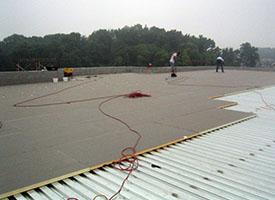Single-ply roofing is popular for commercial buildings due to its durability, energy efficiency, and cost-effectiveness. These membrane roofing systems consist of flexible sheets that are manufactured in a factory and installed in a single layer.
Protecting your Battle Creek, MI commercial investment is the sole focus of Armor Commercial Roofing. Our years of single-ply roofing experience makes us a prime choice for your service needs. To learn more, call 517-617-6953 today and speak with an expert.

Single-Ply Roofing Materials
Thermoplastic Polyolefin (TPO)
TPO membranes have gained significant market share in recent years. Made from polypropylene and ethylene-propylene rubber, TPO offers excellent resistance to ultraviolet light, ozone, and chemical exposure. The material reflects sunlight effectively, reducing cooling costs in warmer climates. TPO is typically white, helping buildings meet energy efficiency standards while providing a clean appearance.
Installation is straightforward with TPO, as sheets can be heat-welded together to create strong, watertight seams. This roofing material is also environmentally friendly, containing no plasticizers and being fully recyclable at the end of its service life, which typically ranges from 15-20 years.
Polyvinyl Chloride (PVC)
PVC roofing membranes have been in use for over 50 years. They’re composed of two layers of PVC with polyester reinforcement scrim in between. PVC offers exceptional chemical resistance, making it ideal for restaurants or industrial facilities where grease or chemicals might be present.
The hot-air welded seams of PVC membranes create bonds stronger than the material itself, virtually eliminating seam failures. PVC is also highly resistant to fire, punctures, and wind damage. With proper installation and maintenance, PVC roofs can last 20-30 years.
Ethylene Propylene Diene Terpolymer (EPDM)
EPDM, commonly known as rubber roofing, is one of the most versatile and economical single-ply options. Made from a synthetic rubber compound, EPDM comes in black or white and is available in various widths and thicknesses.
EPDM’s primary advantages include exceptional weather resistance, flexibility in cold temperatures, and resistance to thermal shock. It handles building movement well and requires minimal maintenance. Traditional black EPDM absorbs heat, which can be beneficial in colder regions. EPDM systems typically last 20-25 years, with some installations performing well for over 30 years.
Thermoplastic Polyvinyl Chloride (PVC-P)
PVC-P membranes, a variation of PVC with added plasticizers for flexibility, offer excellent waterproofing properties and resistance to ponding water. They perform well in harsh weather conditions and provide good chemical resistance.
Choosing the Right Material
When selecting a single-ply roofing material, consider factors like climate conditions, building use, energy efficiency goals, and budget constraints. Each material has its strengths and ideal applications, making consultation with a roofing professional essential for making the best choice for your specific building needs.

Single-Ply Roofing Experts
Single-ply roofing continues to evolve with improvements in manufacturing technology, offering building owners more durable, sustainable, and energy-efficient options than ever before.
To learn more about single-ply roofing systems and the advantages they offer your Battle Creek, MI commercial building, call 517-617-6953.
FAQ
How long do single-ply roofing systems typically last?
Most single-ply roofing systems have a lifespan of 15-30 years, depending on the material used, quality of installation, and maintenance. TPO typically lasts 15-20 years, PVC 20-30 years, and EPDM 20-25 years with proper care.
Are single-ply roofing materials energy efficient?
Yes, many single-ply roofing materials contribute to energy efficiency. Light-colored or white membranes like TPO and white EPDM reflect sunlight and heat away from buildings, reducing cooling costs in warmer climates. Some products qualify for ENERGY STAR® ratings and can help buildings meet green building standards.
What is the most cost-effective single-ply roofing material?
EPDM is generally considered the most economical single-ply option in terms of initial installation costs. However, the true cost-effectiveness depends on factors like climate, building use, and energy considerations. TPO and PVC may offer better long-term value in certain situations despite higher upfront costs.
Can single-ply roofing be installed over existing roof materials?
In many cases, yes. Single-ply membranes can often be installed over existing roofing materials, eliminating the need for costly tear-offs. However, this depends on local building codes, the condition of the existing roof, and structural considerations. A professional roofing contractor should evaluate the roof to determine if an overlay is appropriate.
How are single-ply roofing membranes attached to the roof?
Single-ply membranes can be attached using several methods: fully adhered (glued down), mechanically attached (fastened with screws and plates), or ballasted (held in place with river rock or pavers). The attachment method depends on factors like roof slope, wind exposure, and building use.
Which single-ply roofing material is best for extreme weather conditions?
PVC and EPDM tend to perform best in extreme weather conditions. EPDM offers excellent flexibility in cold temperatures and resistance to hail, while PVC provides superior resistance to high winds and punctures. The best choice depends on the specific climate challenges in your region.
